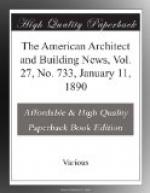Automatic-sprinklers have proved to be a most valuable form of fire-apparatus in operating with great efficiency at fires where their action was unaided by other fire-apparatus, particularly at night. In mill fires the average loss for an experience of twelve years shows that in those fires where automatic-sprinklers formed a part of the apparatus operating upon the fire, the average loss amounted to only one-nineteenth of the average of all other losses. If the difference between these two averages represents the amount saved by the operation of automatic-sprinklers, then the total damage from the number of fires to which automatic-sprinklers are accredited, as forming a portion of the apparatus, has been reduced six and a quarter million dollars by the operation of this valuable device.
Although there have been numerous patents granted to inventors of automatic-sprinklers since the early part of the present century, yet their practical use and introduction has been subsequent to the invention of the sealed automatic-sprinkler by Henry S. Parmelee of New Haven, Ct., about twelve years ago. This device being the first, and for many years the only automatic-sprinkler manufactured and sold, and actually performing service over accidental fires, to him belongs the distinction of being the pioneer, and practically the originator, of the vast work done by automatic-sprinklers in reducing destruction of property by fire.
Although nearly or quite 200,000 Parmelee automatic-sprinklers have been installed, their manufacture has been supplanted by other forms; and the total number of automatic-sprinklers in position at the present time must be about 2,000,000.
When automatic-sprinklers were first introduced there were many apprehensions that leakage, and also excessive water discharged upon small fires, would be sources of damage. In England this opinion found expression in increased insurance rates in buildings where automatic-sprinklers were installed.
The logic of figures shows that this liability to damage is merely nominal in the case of well-constructed sprinklers. An association of underwriters who have given careful attention to the subject obtained the facts that from the automatic-sprinklers installed in some $500,000,000 worth of property insured by them, the average damage from all causes, except fire, was $2.56 per plant per annum.
Although automatic-sprinklers have proved to be so reliable and effective, yet, in order to provide for all possible contingencies, their introduction should not displace other forms of fire-apparatus, particularly stand-pipes in the stairway towers, with hydrants at each story. The hose at these hydrants should be festooned on a row of pins, or doubled on some of the reels made especially for such purposes. Stand-pipes are not recommended to be placed in rooms or on fire-escapes; and inside hydrants should not be attached to the vertical pipes supplying automatic-sprinklers.




